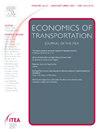Spread valuation and risk on transport infrastructure loans
IF 1.7
3区 工程技术
Q2 ECONOMICS
引用次数: 0
Abstract
For some time now, public administrations in many countries have been subject to strict budgetary constraints to control the public deficit. The Public Private Partnership (PPP) model in this context is a useful vehicle to develop public infrastructures. Despite its attractiveness and potential, there is an accumulation of evidence that questions this model with different experiences showing that PPPs are relatively risky projects for all participants. This is especially true for financial creditors, who usually lend up to 85% of the funds needed for financing the project.
The main objective of this research is to develop a methodology for valuing the financial cost of loans in PPP projects for transportation infrastructure, depending on demand risk. This paper proposes the use of option pricing approach to determine the loan spread in PPP transport projects.
To mitigate the risk faced by project financiers, it would be necessary to guarantee the repayment of the debt service. Given that the project's cash flows are uncertain due to demand risk, the cost associated with this guaranty reflects the risk premium that financiers bear as well as the overall cost of financing.
This guarantee may be determined as a derivative (an option) of the project traffic.
To test this methodology, a real regional toll motorway in Spain has been used, comparing the contractual risk premium of the bank loans obtained with the risk premium calculated by the proposed model.
This research indicates that the spread on concessional loans significantly decreases over time, paralleling the reduction in traffic risk, and is notably higher during the initial years of the project. Furthermore, discrepancies between the projected and actual initial traffic have a substantial impact on the risk assumed by lenders. As limitation of this study, it is important to note that in practice the risk premium incorporates other relevant variables for the project and the industry that are not considered in this study.
交通基础设施贷款的价差估值与风险
一段时间以来,许多国家的公共行政一直受到严格的预算限制,以控制公共赤字。在这种情况下,公私伙伴关系(PPP)模式是发展公共基础设施的有用工具。尽管公私伙伴关系具有吸引力和潜力,但有越来越多的证据表明,不同的经验表明,公私伙伴关系对所有参与者来说都是相对有风险的项目。对于金融债权人来说尤其如此,他们的贷款通常高达项目融资所需资金的85%。本研究的主要目的是根据需求风险,开发一种评估交通基础设施PPP项目贷款财务成本的方法。本文提出采用期权定价方法确定PPP交通项目的贷款利差。为了减轻项目融资者面临的风险,有必要保证偿还债务。鉴于项目的现金流由于需求风险而具有不确定性,因此与此担保相关的成本反映了融资方承担的风险溢价以及融资的总体成本。该保证可以确定为项目流量的派生(选项)。为了验证这一方法,我们使用了西班牙的一个真实的区域收费高速公路,将获得的银行贷款的合同风险溢价与所提出模型计算的风险溢价进行比较。这项研究表明,优惠贷款的息差随着时间的推移而大大减少,与交通风险的减少同时减少,在项目的最初几年明显更高。此外,预计流量和实际初始流量之间的差异对贷款人承担的风险有重大影响。由于本研究的局限性,值得注意的是,在实践中,风险溢价包含了本研究未考虑的项目和行业的其他相关变量。
本文章由计算机程序翻译,如有差异,请以英文原文为准。
求助全文
约1分钟内获得全文
求助全文

 求助内容:
求助内容: 应助结果提醒方式:
应助结果提醒方式:


